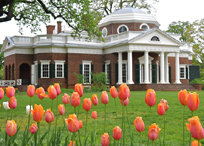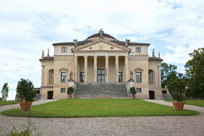Palladio, Jefferson and You

Thomas Jefferson was a founding father of the United States in more ways than one.
Indeed, the author of the Declaration of Independence was also an architectural scholar and dedicated adherent of the philosophy and style of Andrea Palladio (1508-1580), an architect of the Italian Renaissance who derived his elegant lines from ancient Greek and Roman models (as seen to the right in his Villa Rotondo). Following that path, Jefferson did much to make Palladian Neoclassicism the signature “look†of the new republic.
Jefferson was keenly interested in bringing order to the way the new country developed, and he saw in Palladio’s approach the purest and most instructive form of art. His early advocacy of Palladian ideals had much to do with the way Washington, D.C., looks today, with the classical style dominating early public structures from the Capitol Building to the White House and beyond.
But Jefferson’s interest wasn’t limited to grand public edifices: He built his own home at Monticello to reflect his passion for Palladio’s formal approach to defining spatial and visual relationships. In the years since, this style has seen a number of revivals in the form of Neoclassicism, Palladianism and various other movements that flow from Jefferson’s passion for Palladio’s sense of symmetry, scale and proportion.
As is the case with many centuries-old styles that developed without compatible watershapes as part of the package, this leaves modern designers and builders wondering what to do when asked to add aquatic features to these architectural surroundings.
Reappearing Act
Of all the revival movements you can trace through history, few have been as persistent as Palladianism. It is through Palladian revivals, for example, that we see Greek-style porticos on so many public buildings and grand residences beyond the nation’s capital. Palladio and Jefferson were also fascinated by central rotundas and the presentation of large, open spaces at the cores of their buildings. In all things, axial symmetry was a principal virtue and perhaps the dominant visual component of the style in all of its various forms and derivations.
 Jefferson’s home in rural Virginia (seen at left) is a classic example of Palladian design tradition worked out on a residential scale. In plan view, the home reveals a formal quadrant-based layout, with multiple entrances accessing the main, central space. As is true of much early American architecture in this style, brick was the primary building material, with concrete or stone serving as the medium for moldings, columns, pediments and casings.
Jefferson’s home in rural Virginia (seen at left) is a classic example of Palladian design tradition worked out on a residential scale. In plan view, the home reveals a formal quadrant-based layout, with multiple entrances accessing the main, central space. As is true of much early American architecture in this style, brick was the primary building material, with concrete or stone serving as the medium for moldings, columns, pediments and casings.
With its relatively modest (but nonetheless impressive) scale, I have always seen Monticello as a place where the observant watershaper can get all the cues he or she needs to design watershapes that will be perfectly suited to Palladian surroundings. Jefferson didn’t leave us much to work with directly, but by understanding the appropriate materials and design techniques, we can dig inside the style and find a range of elegant aquatic solutions.
We can, for instance, look at the physical forms that were prevalent and consider the materials that are indicative of the style. In this case, classic, proportionate Roman rectangles certainly work in designing, say, reflecting or swimming pools. But Jefferson was also partial to octagons, which would be perfectly appropriate for fountain basins. Brick, concrete and stone are all acceptable materials; you just need to use them with appropriate style.
Measured Approaches
In considering appropriateness, I find that it always helps to do a bit of creative editing. I would step away from, for example, laminar nozzles and colored LED lighting: To use them, I think, would violate the spirit of Palladian architectural forms. They represent a measure of sizzle that goes a few paces beyond the sort of restraint the style requires.
Restraint is, in fact, the key word here. If you can shake off the tendency to pull products off the shelf and focus instead on making design decisions that are consistent with the formality of the Palladian style – if you can keep your focus on accurately following the many models Jefferson and others inspired by him have provided for us through the past 200 years – then there are multiple creative paths you can follow to bring water to these environments.
Here as elsewhere, the art of watershaping is all about being aware of the central concepts at play in any given style and translating those ideas to aquatic form with an eye to materials that work, details that are appropriate and physical forms that complement the architecture.
Often this means swallowing your ego; in this specific Palladian case, do you really think you’re ready to go toe-to-toe with Thomas Jefferson?
Mark Holden is a landscape architect, pool contractor and teacher who owns and operates Holdenwater, a design/build/consulting firm based in Fullerton, Calif., and is founder of Artistic Resources & Training, a school for watershape designers and builders. He may be reached via e-mail at [email protected].










